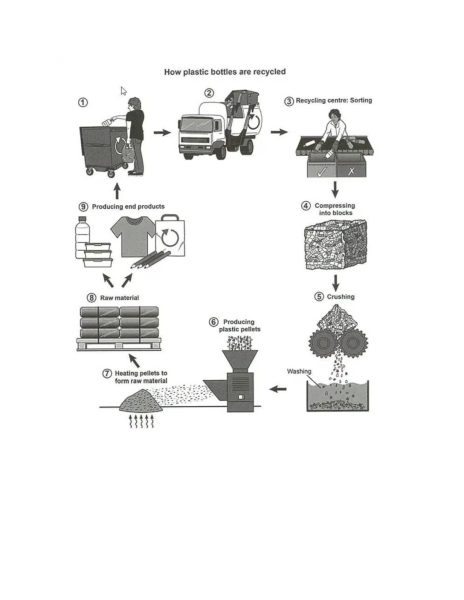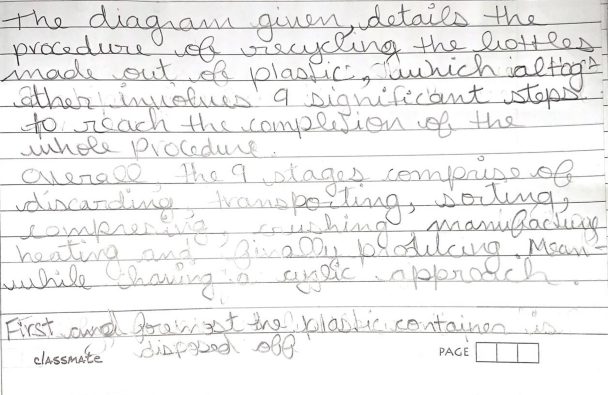-
Task 1 (Process Diagram)
Posted by Isha Singha on June 23, 2022 at 8:37 PMThe diagram below shows the process for recycling plastic bottles.
Summarise the information by selecting and reporting the main features, and make comparisons where relevant.
noor replied 3 years, 5 months ago 6 Members · 9 Replies -
9 Replies
-
The diagram above depicts the recycling process of plastic bottles where it passes through a series of process and finally ending into a final product.
The entire process can be sub divided into 5 major areas, which includes collection from local sources, sorting of usable plastics, cleaning the plastics to make it free from contaminants, processing into usable pre-forms for the end products and finally into the end product which are various household objects.
The process starts with collection of the discarded plastic bottles from local dustbins, which are being collected using the waste collection trucks and brought to the nearest material sorting facility. In the sorting facility the usable plastic bottles are segregated from the unwanted plastics manually by the workers, over the conveyor. Once sorted, the raw material is then compressed into bales which can be transported easily to the cleaning facility. To make the cleaning process more efficient, in the cleaning section the bales are broken down into fine pieces using large shredders. Once shredded the pieces are then cleaned thoroughly inside a large tank which is placed under the crusher.
After cleaning the raw material or the shredded plastic pieces are fed into a parallelization machine to form plastic pellets. The pellets are then heated at a high temperature where it melts and becomes the raw material for the end product. The raw material then formed are passed through various processes to manufacture desired products used in our daily life like T-shirts, bottles, storage containers, pens. etc.
-
The diagram above depicts the recycling process of plastic bottles where it passes through a series of process and finally ending into a final product.
The entire process can be subdivided into five major areas, which include collection from local sources, sorting of usable plastics, cleaning the plastics to make it free from contaminants, processing into usable pre-forms for the end products, and finally into the end products, which are various household objects.
The process starts with the collection of the discarded plastic bottles from local dustbins, which are collected using waste collection trucks and brought to the nearest material sorting facility. At the sorting facility, the usable plastic bottles are segregated from the unwanted plastics by hand by the workers, over the conveyor. Once sorted, the raw material is then compressed into bales which can be transported easily to the cleaning facility. To make the cleaning process more efficient, in the cleaning section, the bales are broken down into fine pieces using large shredders. Once shredded, the pieces are then cleaned thoroughly inside a large tank which is placed under the crusher.
After cleaning, the raw material or the shredded plastic pieces are fed into a parallelization machine to form plastic pellets. The pellets are then heated at a high temperature where they melt and become the raw material for the end product. The raw material, then formed, is passed through various processes to manufacture desired products used in our daily life like T-shirts, bottles, storage containers, pens. etc.
Feedback:
-Nice attempt.
– Grammatical errors like subject verb agreement.
-Avoid using same words repeatedly.
Bands – 2/3
-
-
<div> The given process diagram describes the recycling process of plastics.
</div><div></div><div>
The cycle can be divided into eight namely proper disposal, collection ,sorting, compression, crushing , fine grinding, conversion to raw material and finally conversion to useful products. The change of state for each of these categories will be discussed here.
</div><div>
The first four stages of these processes are described here beginning with proper disposal of the plastics which could be collected from the designated area to a sorting center. Proper sorting is necessary for effective recycling which determines the quality of end product. Furthermore the sorted materials are then compressed, which will reduce storage space and helps in efficient transport.
</div><div>
The last five stages are more technically advanced, the compressed blocks are crushed and washed. The clean material obtained is further processed by converting them into fine pellets. These pellets are then heat treated which transforms them into raw material. The final stage of the cycle is conversion of raw material into useful produce that can be distributed back into the market.
</div>
-
The given process diagram describes the recycling process of plastics.
The cycle can be divided into eight steps, namely proper disposal, collection ,sorting, compression, crushing , fine grinding, conversion to raw material and finally conversion to useful products. The change of state for each of these categories will be discussed here.
The first four stages of these processes are described here, beginning with the proper disposal of the plastics that could be collected from the designated area to a sorting center. Proper sorting is necessary for effective recycling, which determines the quality of the end product. Furthermore, the sorted materials are then compressed, which will reduce storage space and help in efficient transport.
The last five stages are more technically advanced. The compressed blocks are crushed and washed. The clean material obtained is further processed by converting it into fine pellets. These pellets are then heat treated, which transforms them into raw material. The final stage of the cycle is the conversion of raw material into useful produce that can be distributed back into the market.
Feedback:
Nice work!
Be careful about punctuation and articles.
Bands – 2.5/3
-
-
The given diagram illustrates the process of making materials from reusable plastics by recycling plastic bottles.
Looking from an overall perspective, the entire process consists of stages such as bottles collection from bins, sort them if recyclable, compress and crush to produce pellets and convert pellets to create raw materials and various products.
To start with, consumers dispose the used plastic bottles in recycling bins, which are in turn picked up by the garbage collector vehicles and transport them to recycling centers. At the recycling center, bottles are sorted by hand as per the quality and recyclable plastics are compressed into cube shaped boxes. These boxes are then crushed to form smaller plastic pieces.
Consequently, these particles are washed and fed into a machine which produces plastic pellets. These pellets then heated to create raw materials. Finally, the raw materials will be used to manufacture end products such as bottles, tiffin boxes, bags, T-shirts and pencils.
-
The given diagram illustrates the process of making materials from reusable plastics by recycling plastic bottles.
Looking from an overall perspective, the entire process consists of stages such as bottle collection from bins; sorting them if recyclable; compressing and crushing to produce pellets; and converting pellets to create raw materials and various products.
To start with, consumers dispose the used plastic bottles in recycling bins, which are in turn picked up by the garbage collector vehicles and transport them to recycling centers. At the recycling center, bottles are sorted by hand as per quality, and recyclable plastics are compressed into cube shaped boxes. These boxes are then crushed to form smaller plastic pieces.
Consequently, these particles are washed and fed into a machine which produces plastic pellets. These pellets are then heated to create raw materials. Finally, the raw materials will be used to manufacture end products such as bottles, tiffin boxes, bags, T-shirts, and pencils.
Feedback:
Some grammatical errors.
Nice attempt!
Bands – 2.5/3
-
-
The process diagram illustrates a cyclic process for recycling plastic bottles.
There are nine steps in this procedure . The initial stage of the recycling starts with collection of the waste plastic bottles and in final stage there is production of new products from waste.
The first stage comprises of collection of plastic bottles in a dustbin. After that, a truck comes to collect this waste and to take it to a site where the procedure can be started. Then, in the recycling centre the sorting of these bottles is done with hands. Furthermore, the processing starts and they are compressed into blocks.
The next stage comprises of crushing the blocks and washing the extracted material. After this the plastic pellets are produced in the specialised machinery. Then these pellets are heated and the raw material is formed. The raw material is processed and is used for the production of recycled end materials like T-shirts, pens, pencils etc.
-
The process diagram illustrates a cyclic process for recycling plastic bottles.
There are nine steps in this procedure . The initial stage of recycling starts with the collection of the waste plastic bottles, and in the final stage there is the production of new products from waste.
The first stage comprises the collection of plastic bottles in a dustbin. After that, a truck comes to collect this waste and take it to a site where the procedure can be started. Then, in the recycling centre, the sorting of these bottles is done by hand. Furthermore, the processing starts and they are compressed into blocks.
The next stage comprises crushing the blocks and washing the extracted material. After this, the plastic pellets are produced on the specialised machinery. Then these pellets are heated and the raw material is formed. The raw material is processed and is used for the production of recycled end products like T-shirts, pens, pencils, etc.
Nice work
Bands – 2/3
-
Log in to reply.




